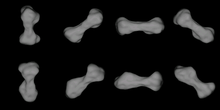216 Kleopatra
216 Kleopatra is a Main belt asteroid found by Johann Palisa on April 10, 1880 in Pola. It is named after Cleopatra, the Queen of Egypt. It is a dumbbell-shaped M-class (metallic) asteroid.
| Discovery | |
|---|---|
| Discovered by | Johann Palisa |
| Discovery date | April 10, 1880 |
| Designations | |
| A905 OA, A910 RA | |
| Main belt | |
| Orbital characteristics | |
| Epoch 30 January, 2005 (JD 2453400.5) | |
| Aphelion | 523.049 Gm (3.496 AU) |
| Perihelion | 312.544 Gm (2.089 AU) |
| 417.796 Gm (2.793 AU) | |
| Eccentricity | 0.252 |
| 1704.704 d (4.67 a) | |
Average orbital speed | 17.82 km/s |
| 55.259° | |
| Inclination | 13.136° |
| 215.672° | |
| 179.099° | |
| Physical characteristics | |
| Dimensions | 217 × 94 × 81 km |
| Mass | unknown |
Mean density | 3.5+ |
| 5.385 h | |
| Albedo | 0.116 |
| Temperature | unknown |
Spectral type | M |
| 7.3 | |

Kleopatra is an unusual object. Its odd shape was revealed by adaptive optics on the ESO 3.6m telescope at La Silla. By bouncing radar signals off the asteroid, a team of astronomers at the Arecibo radio telescope in Puerto Rico were able to develop a more detailed computer model of its shape, which confirmed the dog-bone like shape. A favored explanation is that Kleopatra is a contact binary: two similarly-sized asteroids that have hit and stuck together instead of breaking apart.
Kleopatra is a fairly big asteroid, measuring 217 × 94 × 81 km. It is believed to be a loosely packed metallic object, based on its radar albedo.
Other websites
change- Bilobated shape of 216 Kleopatra
- Astronomers Catch Images of Giant Metal Dog Bone Asteroid – NASA article
- An Asteroid for the Dogs Archived 2004-02-28 at the Wayback Machine
References
change- The Asteroid Orbital Elements Database[permanent dead link]
- Minor Planet Discovery Circumstances
- Asteroid Lightcurve Data FileArchived 2010-07-20 at the Wayback Machine